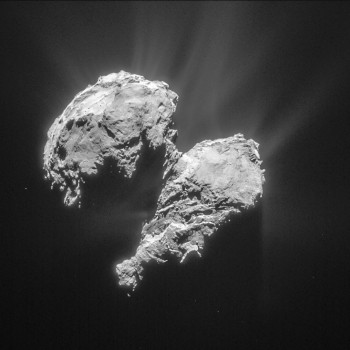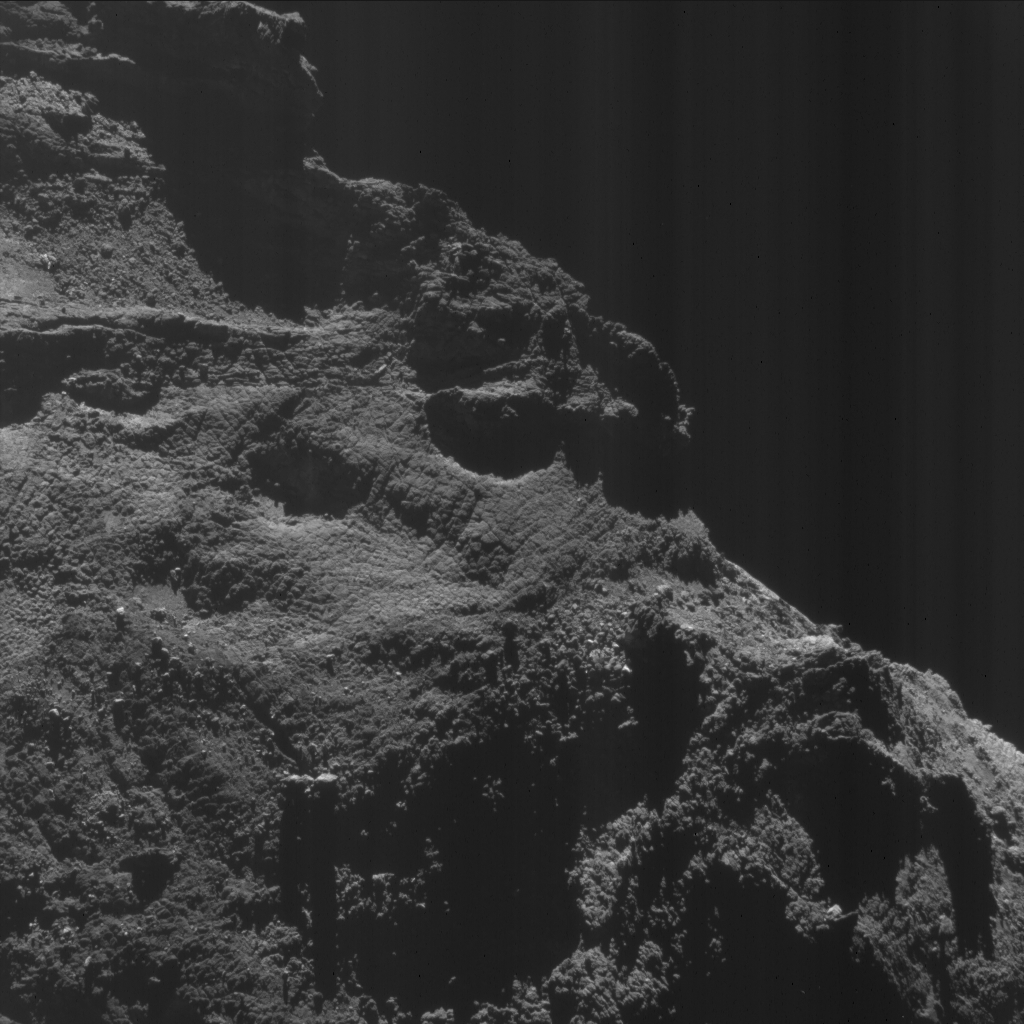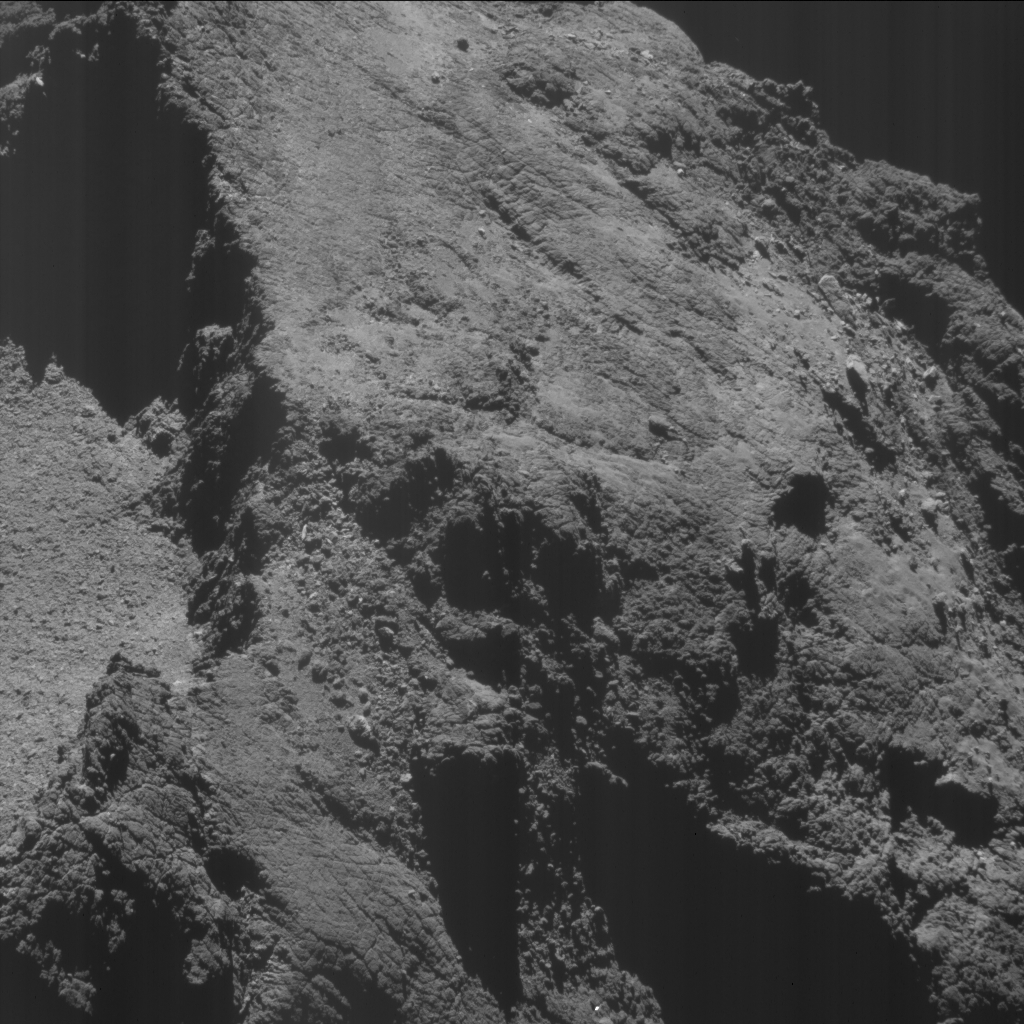.
26.07.2016




HOW COMETS ARE BORN
This story is mirrored from the ESA Web Portal.
Detailed analysis of data collected by Rosetta show that comets are the ancient leftovers of early Solar System formation, and not younger fragments resulting from subsequent collisions between other, larger bodies.
Understanding how and when objects like Comet 67P/Churyumov–Gerasimenko took shape is of utmost importance in determining how exactly they can be used to interpret the formation and early evolution of our Solar System.
A new study addressing this question led by Björn Davidsson of the Jet Propulsion Laboratory, California Institute of Technology in Pasadena (USA), has been published in Astronomy & Astrophysics.
If comets are primordial, then they could help reveal the properties of the solar nebula from which the Sun, planets and small bodies condensed 4.6 billion years ago, and the processes that transformed our planetary system into the architecture we see today.
The alternative hypothesis is that they are younger fragments resulting from collisions between older ‘parent’ bodies such as icy trans-Neptunian objects (TNOs). They would then provide insight into the interior of such larger bodies, the collisions that disrupted them, and the process of building new bodies from the remains of older ones.
“Either way, comets have been witness to important Solar System evolution events, and this is why we have made these detailed measurements with Rosetta – along with observations of other comets – to find out which scenario is more likely,” says Matt Taylor, ESA’s Rosetta project scientist.
During its two-year sojourn at Comet 67P/Churyumov–Gerasimenko, Rosetta has revealed a picture of the comet as a low-density, high-porosity, double-lobed body with extensive layering, suggesting that the lobes accumulated material over time before they merged.
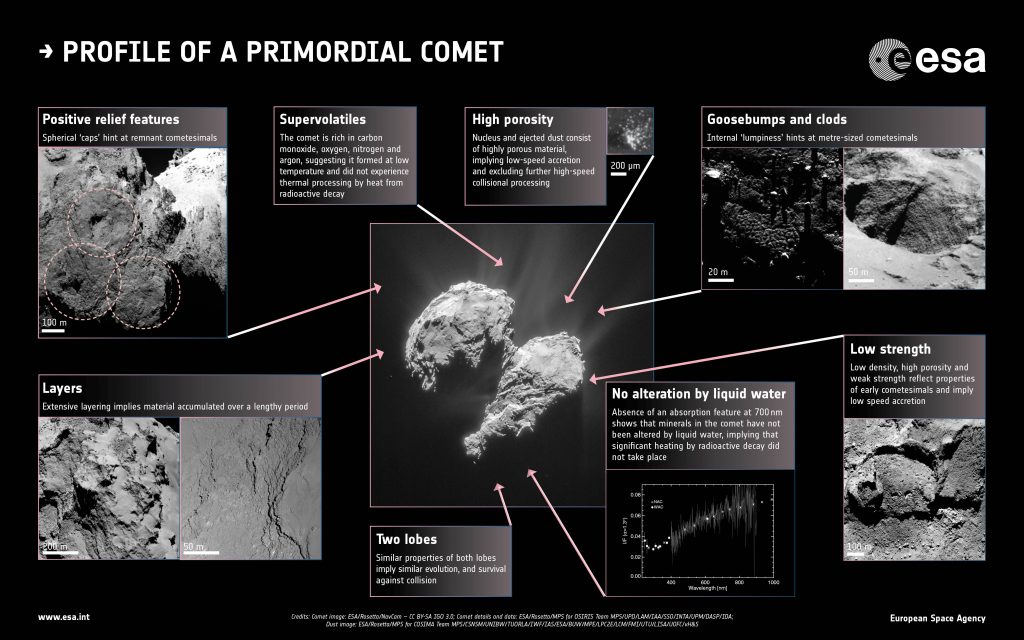
Evidence that Comet 67P/Churyumov–Gerasimenko is composed of ancient material preserved from the formation of the early Solar System and that came together under low speed. The evidence collected by Rosetta lies in the comet’s structural properties, the gases detected leaving the nucleus, and observations of surface features. Credits: Centre: ESA/Rosetta/NavCam – CC BY-SA IGO 3.0; Insets: ESA/Rosetta/MPS for OSIRIS Team MPS/UPD/LAM/IAA/SSO/INTA/UPM/DASP/IDA; ESA/Rosetta/MPS for COSIMA Team MPS/CSNSM/UNIBW/TUORLA/IWF/IAS/ESA/BUW/MPE/LPC2E/LCM/FMI/UTU/LISA/UOFC/vH&S
The unusually high porosity of the interior of the nucleus provides the first indication that this growth cannot have been via violent collisions, as these would have compacted the fragile material. Structures and features on different size scales observed by Rosetta’s cameras provide further information on how this growth may have taken place.
Earlier work showed that the head and body were originally separate objects, but the collision that merged them must have been at low speed in order not to destroy both of them. The fact that both parts have similar layering also tells us that they must have undergone similar evolutionary histories and that survival rates against catastrophic collision must have been high for a significant period of time.
Merging events may also have happened on smaller scales. For example, three spherical ‘caps’ have been identified in the Bastet region on the small comet lobe, and suggestions are that they are remnants of smaller cometesimals that are still partially preserved today.
At even smaller scales of just a few metres across, there are the so-called ‘goosebumps’ and ‘clod’ features, rough textures observed in numerous pits and exposed cliff walls in various locations on the comet.
While it is possible that this morphology might arise from fracturing alone, it is actually thought to represent an intrinsic ‘lumpiness’ of the comet’s constituents. That is, these ‘goosebumps’ could be showing the typical size of the smallest cometesimals that accumulated and merged to build up the comet, made visible again today through erosion due to sunlight.
According to theory, the speeds at which cometesimals collide and merge change during the growth process, with a peak when the lumps have sizes of a few metres. For this reason, metre-sized structures are expected to be the most compact and resilient, and it is particularly interesting that the comet material appears lumpy on that particular size scale.
Further lines of evidence include spectral analysis of the comet’s composition showing that the surface has experienced little or no in situ alteration by liquid water, and analysis of the gases ejected from sublimating ices buried deeper within the surface, which finds the comet to be rich in supervolatiles such as carbon monoxide, oxygen, nitrogen and argon.
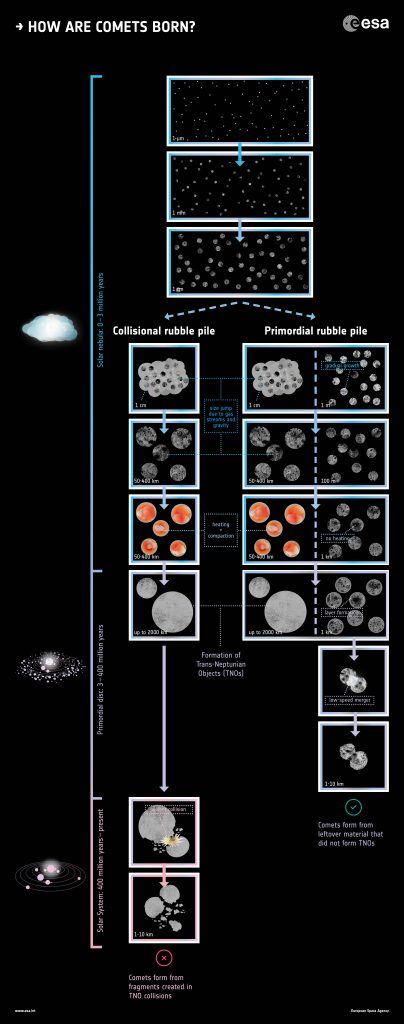
The two main scenarios for the formation of comets: collisional (left) vs. primordial (right) rubble pile. Evidence collected by Rosetta strongly favours the primordial rubble pile hypothesis, namely that comets were built up slowly through low-speed accumulation of material into the shapes observed today. Credit: ESA
These observations imply that comets formed in extremely cold conditions and did not experience significant thermal processing during most of their lifetimes. Instead, to explain the low temperatures, survival of certain ices and retention of supervolatiles, they must have accumulated slowly over a significant time period.
“While larger TNOs in the outer reaches of the Solar System appear to have been heated by short-lived radioactive substances, comets don’t seem to show similar signs of thermal processing. We had to resolve this paradox by taking a detailed look at the time line of our current Solar System models, and consider new ideas,” says Björn.
Björn and colleagues propose that the larger members of the TNO population formed rapidly within the first one million years of the solar nebula, aided by turbulent gas streams that rapidly accelerated their growth to sizes of up to 400 km.
Around three million years into the Solar System’s history, gas had disappeared from the solar nebula, only leaving solid material behind. Then, over a much longer period of around 400 million years, the already massive TNOs slowly accreted further material and underwent compaction into layers, their ices melting and refreezing, for example. Some TNOs even grew into Pluto or Triton-sized objects.
Comets took a different path. After the rapid initial growth phase of the TNOs, leftover grains and ‘pebbles’ of icy material in the cold, outer parts of the solar nebula started to come together at low velocity, yielding comets roughly 5 km in size by the time gas has disappeared from the solar nebula. The low speeds at which the material accumulated led to objects with fragile nuclei with high porosity and low density.
This slow growth also allowed comets to preserve some of the oldest, volatile-rich material from the solar nebula, since they were able to release the energy generated by radioactive decay inside them without heating up too much.
The larger TNOs played a further role in the evolution of comets. By ‘stirring’ the cometary orbits, additional material was accreted at somewhat higher speed over the next 25 million years, forming the outer layers of comets. The stirring also made it possible for the few kilometre-sized objects in size to bump gently into each other, leading to the bi-lobed nature of some observed comets.
“Comets do not appear to display the characteristics expected for collisional rubble piles, which result from the smash-up of large objects like TNOs. Rather, we think they grew gently in the shadow of the TNOs, surviving essentially undamaged for 4.6 billion years,” concludes Björn.
“Our new model explains what we see in Rosetta’s detailed observations of its comet, and what had been hinted at by previous comet flyby missions.”
“Comets really are the treasure-troves of the Solar System,” adds Matt.
“They give us unparalleled insight into the processes that were important in the planetary construction yard at these early times and how they relate to the Solar System architecture that we see today.”
---
NEW VANGELIS ALBUM INSPIRED BY ESA’S ROSETTA MISSION
Legendary composer and pioneer of electronic music Vangelis has produced a brand new album, ‘Rosetta’, inspired by ESA’s Rosetta mission.
 The release of the album by Decca Records on 23 September coincides with the culmination of Rosetta’s 12-year mission to orbit and land its Philae probe on Comet 67P/Churyumov-Gerasimenko. Rosetta is set to complete its journey in a controlled descent to the surface of the comet on 30 September.
The release of the album by Decca Records on 23 September coincides with the culmination of Rosetta’s 12-year mission to orbit and land its Philae probe on Comet 67P/Churyumov-Gerasimenko. Rosetta is set to complete its journey in a controlled descent to the surface of the comet on 30 September.
The story of this mission fuelled Vangelis’ long-held passion for space and inspired him to create his first new studio album in 18 years.
Vangelis’ music is often linked to themes of science, history and exploration. Alongside his Academy Award-winning score for ‘Chariots of Fire’, he has written for the films including ‘Antarctica’, ‘1492: Conquest of Paradise’, ‘The Bounty’ and ‘Alexander’.
“Mythology, science and space exploration are subjects that have fascinated me since my early childhood. And they were always connected somehow with the music I write,” said Vangelis.
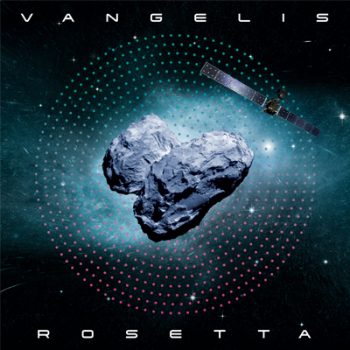
ESA’s connection with Vangelis goes back several years to when ESA astronaut André Kuipers was on the International Space Station. André is a big fan and he had a lot of Vangelis’ music with him in space.
After sharing stories and experiences with André via video call from the ISS, Vangelis was inspired to write some music for ESA to mark the landing of Philae on the comet in 2014.
To Vangelis, music is a sacred, basic force of the Universe, its purpose to elevate, inspire and to heal humankind. Never has this been more obvious than on ‘Rosetta’, an album that perfectly blends his fascination with the Universe and his ability to compose stirring music.
“With music, you can enhance emotions and create memories: I believe that what Vangelis wanted to do was share a lasting memory of our Rosetta mission through his music,” said Carl Walker, from ESA’s Communication Department.
Vangelis has dedicated this new album to everyone who made the ESA’s ongoing Rosetta mission possible, in particular extending the track called ‘Rosetta’s Waltz’ as an expression of his appreciation to the mission team.
“Rosetta has been an amazing journey for everybody involved, both scientifically and technically, but it has also connected emotionally with so many people around the world,” said ESA’s Prof. Mark McCaughrean, Senior Science Advisor in the Directorate of Science.
“So you can imagine how proud we were when one of the world’s great composers Vangelis made some music for us at the time of landing, and how excited we are that he’s put together a whole album of original music about this astonishing adventure.”
More info
Announcement from udiscovermusic: http://www.udiscovermusic.com/vangelis-re-enters-the-stratosphere
---
COMETWATCH 24 JULY
This stunning view along the boundary between Hatmehit and Wosret was captured by Rosetta’s NAVCAM on 24 July from a distance of 9.7 km to the centre of Comet 67P/Churyumov-Gerasimenko.
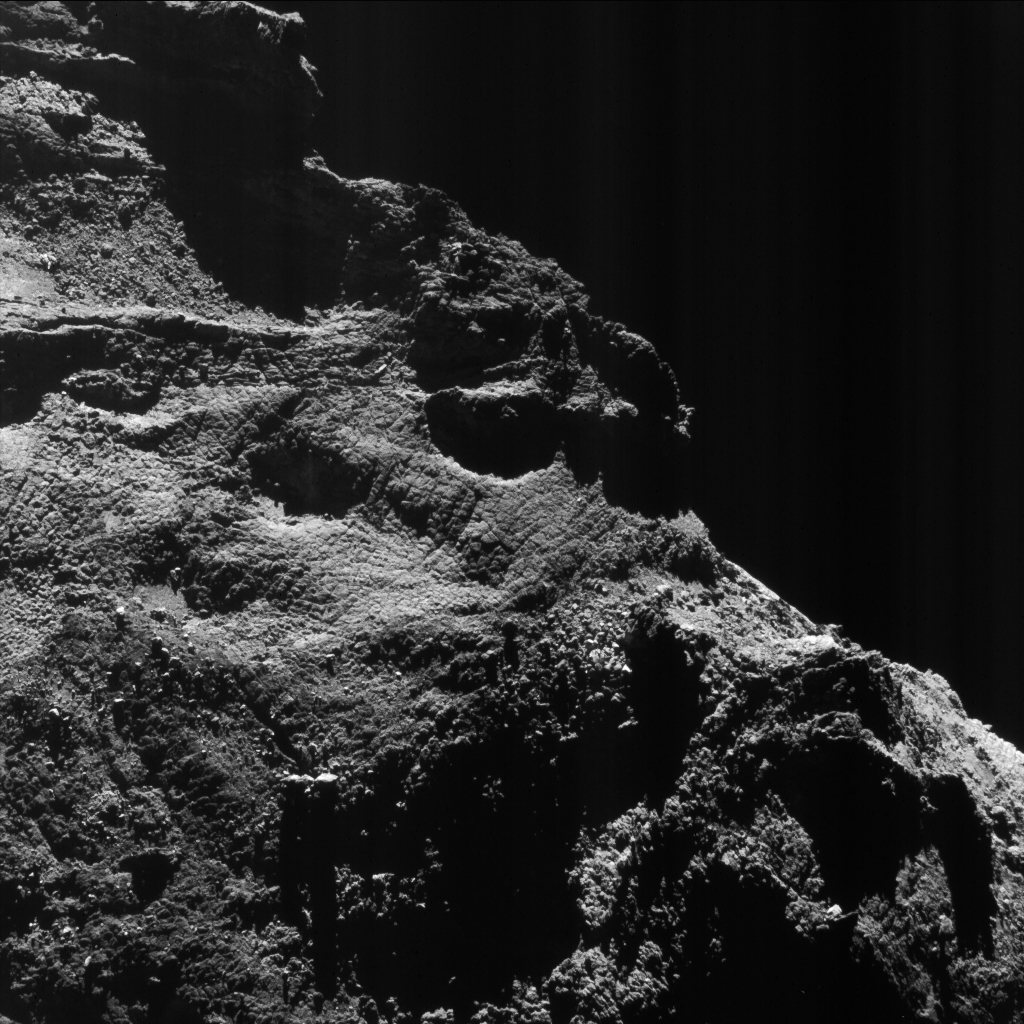
Enhanced NAVCAM view of Comet 67P/Churyumov-Gerasimenko, taken from a distance of 9.7 km on 24 July 2016. The image scale is 0.8 m/pixel and the image measures 0.9 km across. Credits: ESA/Rosetta/NAVCAM – CC BY-SA IGO 3.0
The field of view includes the CONSERT search ellipse that has guided the search for Rosetta’s lander Philae since it landed unexpectedly in the yet-to-be identified location known as Abydos (check this animation for a reminder of the search area).
The image also captures beautiful details of the cross-cutting fracture patterns that prevail in many locations all over the comet; they are particularly prominent towards the left of this scene.
Numerous boulders cling to the surface, and in some places – notably in the lower left quadrant of the image – cast impressively long shadows across the comet’s surface. To the right and above, long shadows are also cast by local variations in topography.
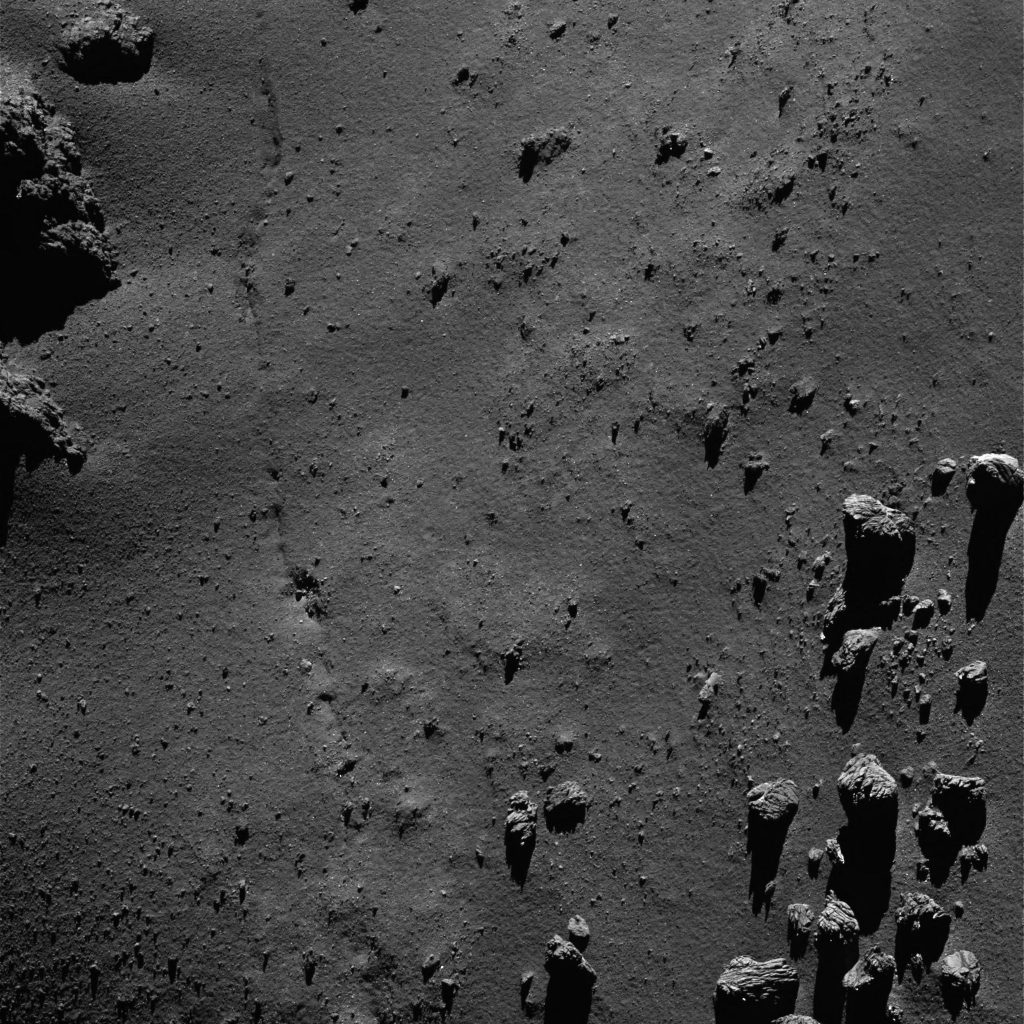
OSIRIS narrow-angle camera image taken on 20 July 2016, when Rosetta was 9.1 km from the centre of Comet 67P/Churyumov–Gerasimenko. The scale is 0.16 m/pixel at the comet and the image measures about 330 m. Credits: ESA/Rosetta/MPS for OSIRIS Team MPS/UPD/LAM/IAA/SSO/INTA/UPM/DASP/IDA
Meanwhile a close-up view of part of the ‘neck’ region of the comet, Hapi, was released via the OSIRIS Image of the Day site earlier this week (above). It shows hints of the crack snaking through the Hapiregion, with some portions apparently infilled by dust.
This image also shows incredible details on the boulders and outcropping material that pockmark the smooth, dust-laden neck, with fractures permeating even at these smaller scales.
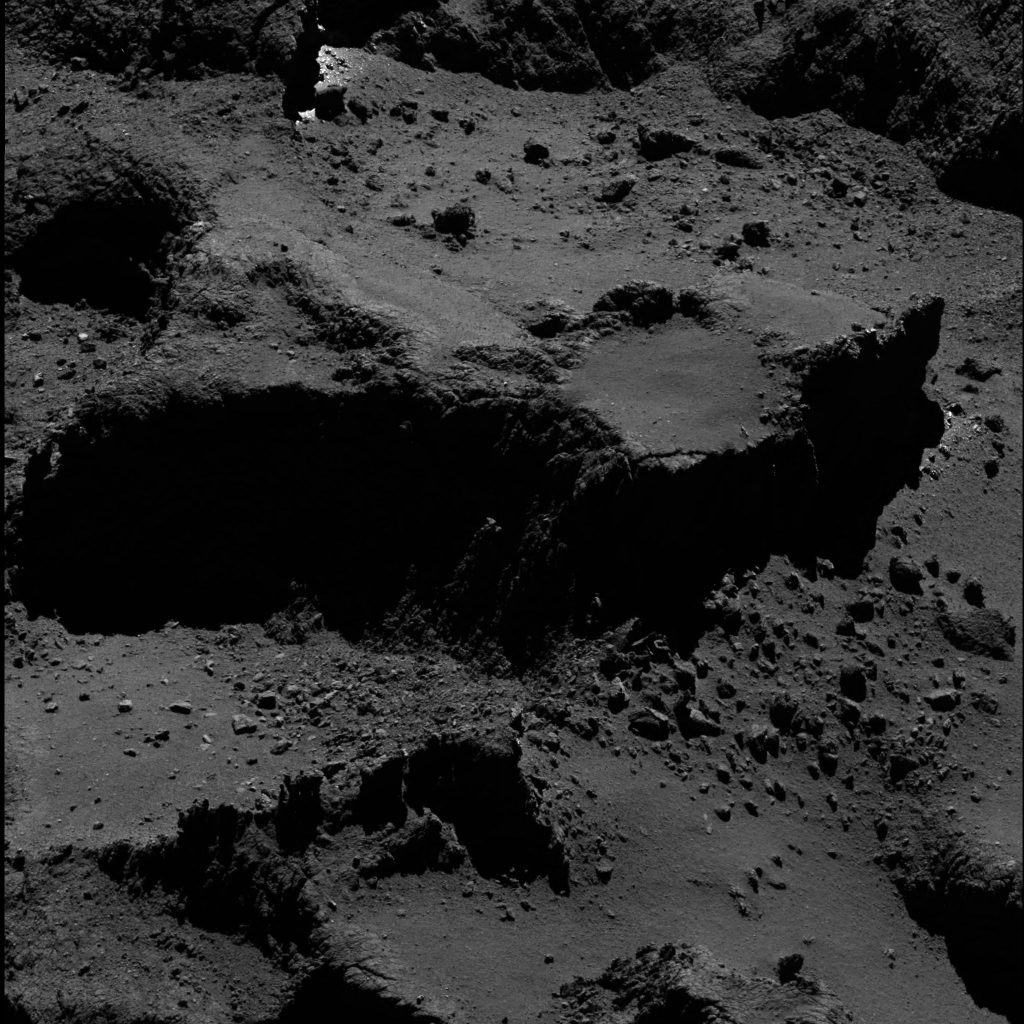
OSIRIS wide-angle camera image taken on 23 July 2016, when Rosetta was 9.6 km from the centre of Comet 67P/Churyumov–Gerasimenko. The scale is 0.16 m/pixel at the comet and the image measures about 330 m. Credits: ESA/Rosetta/MPS for OSIRIS Team MPS/UPD/LAM/IAA/SSO/INTA/UPM/DASP/IDA
Fractures of a different kind are seen in the OSIRIS narrow-angle camera image taken 23 July and released yesterday (above), notably the fracture along the cliff edge close to the centre of the image. Fractures like these have been spotted along the edges of numerous cliffs in this region – Seth – and are likely a precursor to collapse, as suggested by the jumbled debris that is typically seen at the base of cliffs.
The original 1024 x 1024 pixel image for today’s NAVCAM image is provided below:our email address will not be published. Required fields are marked
COMETWATCH 6 AUGUST – TWO YEARS ON
Two incredible years have passed since ESA’s comet-chaser Rosetta arrived at Comet 67P/Churyumov-Gerasimenko on 6 August 2014.
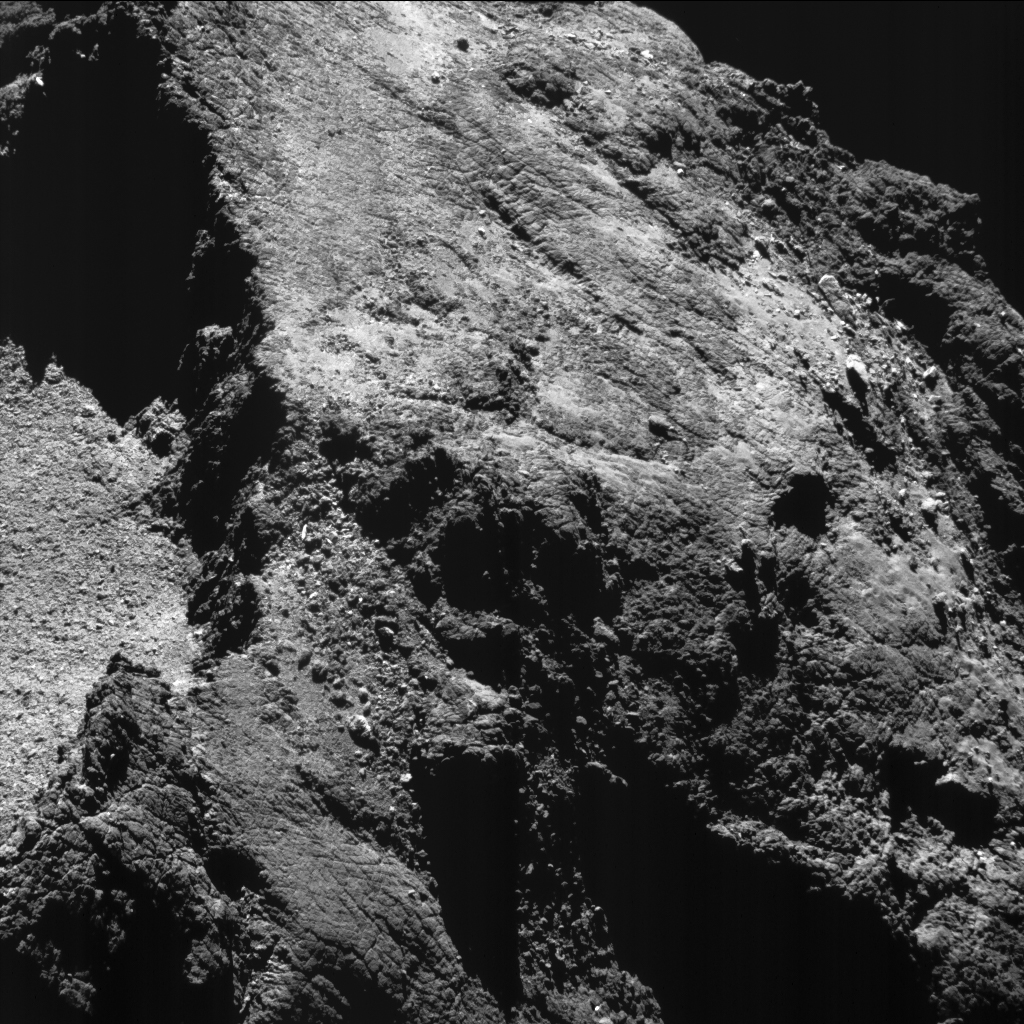
Enhanced image of comet 67P/Churyumov-Geraimsenko, taken by Rosetta's NAVCAM from a distance of 8.5 km. The scale is 0.7 m/pixel and the image measures about 700 m across. Credits: ESA/Rosetta/NavCam – CC BY-SA IGO 3.0
During that time Rosetta has mapped the comet’s curious shape and given us awe-inspiring views from near and far, spotting changes in its surface features and watching as jets of gas and dust stream out in to space – sometimes unexpectedly as sudden outbursts.
The spacecraft has performed daring close flybys and made distant excursions to sample gas, dust and plasma at a range of distances, giving unparalleled insight into the processes that operate at the comet and how it interacts with its environment as it hurtles through space.
In two years, the comet has travelled around 1.5 billion km along its orbit around the Sun, passing through perihelion last August – its closest approach to the Sun – and putting on a spectacular fireworks display as its activity reached a maximum.
Unlike this time last year, when the comet was so active that Rosetta could only observe it from a safe distance of 200–300 km, the activity has since subsided and the spacecraft is now operating at much closer distances, as reflected in this image, captured on 6 August 2016 from 8.5 km. The scale is 0.7 m/pixel and the image measures about 700 m across.
It shows a close-up view of part of the comet’s small lobe, encapsulating some of the large depression known as Hatmehit and its steep cliff walls (left), and the contrasting heavily fractured terrain of Wosret (bottom) and Bastet (top). A portion of the horizon is also captured in the distance, at the top right.
Local variations in topography and individual large boulders cast impressive shadows across the scene. For example, the details of the cliff edge at the top left are recorded in the shadows it casts on the floor below.
The area close to the bottom of the image has been the focus of imaging campaigns attempting to find Rosetta’s lander Philae, where it is thought to have bounced in November 2014, but has yet to be confirmed.
With Rosetta still flying alongside, the comet is now heading back towards the outer Solar System. As such, power is falling, and Rosetta’s thrilling mission will soon conclude in a grand finale: it will make a controlled impact onto the surface of the comet on 30 September.
This image is featured as ESA's Space Science Image of the Week.
The original image is provided below:
Quelle: NASA
-
Update: 12.08.2016
.

IDWAC_2016-08-10T16.05.32.755Z_ID10_1397549600_F12Date taken2016-08-10T16:07:00.861 (UTC)CameraWide Angle CameraFilterEmpty (-) / R (630 nm)Exposure time0.500 sPixel resolution1.18 m/px at 67P/CGProcessing levelRawDistance Rosetta ↔ 67P/CG12.796 kmDistance 67P/CG ↔ Sun531475712 km3.552696 AUDistance Rosetta ↔ Earth627788480 km4.196507 AU
Credit: ESA/Rosetta/MPS for OSIRIS Team MPS/UPD/LAM/IAA/SSO/INTA/UPM/DASP/IDA
Subscribe to the mailing list by e-mailing your request to osiris-pi@mps.mpg.de.
OSIRIS was built by a consortium led by the Max-Planck-Institut für Sonnensystemforschung, Göttingen, Germany, in collaboration with CISAS, University of Padova, Italy, the Laboratoire d'Astrophysique de Marseille, France, the Instituto de Astrofísica de Andalucia, CSIC, Granada, Spain, the Scientific Support Office of the European Space Agency, Noordwijk, The Netherlands, the Instituto Nacional de Técnica Aeroespacial, Madrid, Spain, the Universidad Politécnica de Madrid, Spain, the Department of Physics and Astronomy of Uppsala University, Sweden, and the Institut für Datentechnik und Kommunikationsnetze der Technischen Universität Braunschweig, Germany.
Quelle: ESA
---
COMETWATCH – EARLY AUGUST ROUND-UP
Today’s CometWatch entry features a new image from Rosetta’s NAVCAM (below) along with a round-up of images released from the OSIRIS narrow- and wide-angle cameras in the last week.
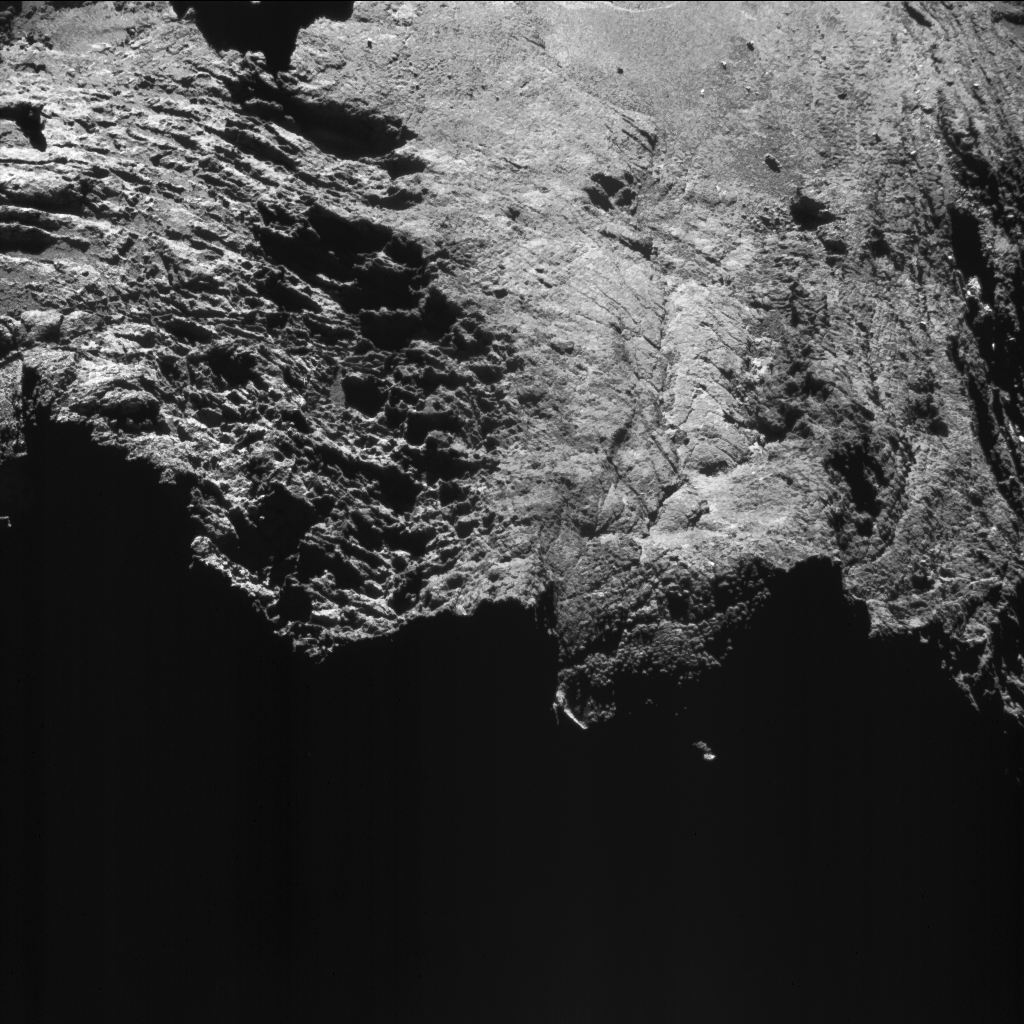
Enhanced NAVCAM image taken from a distance of 10.6 km to the centre of comet 67P/Churyumov-Gerasimenko on 8 August 2016. The image scale is 0.9 m/pixel and the image measures about 930 m across. Credits: ESA/Rosetta/NAVCAM – CC BY-SA IGO 3.0.
The NAVCAM image, taken from a distance of about 10.6 km from Comet 67P/Churyumov-Gerasimenko on 8 August, shows a spectacular close-up of details close to the boundary of Atum (foreground and left) and Anubis (the smoother region towards the top).
To the left, the scene shows exposed layers with smoother material lying in between, which transitions into a heavily eroded zone before taking on a smoother appearance again in the centre, albeit scarred with fracture-like features cross-cutting at a range of scales. Layers can also be picked out towards the top right, some of which have the appearance of being folded, as seen in other images of the Anubis region.
The OSIRIS team have also shared a number of new views via their image of the day website.
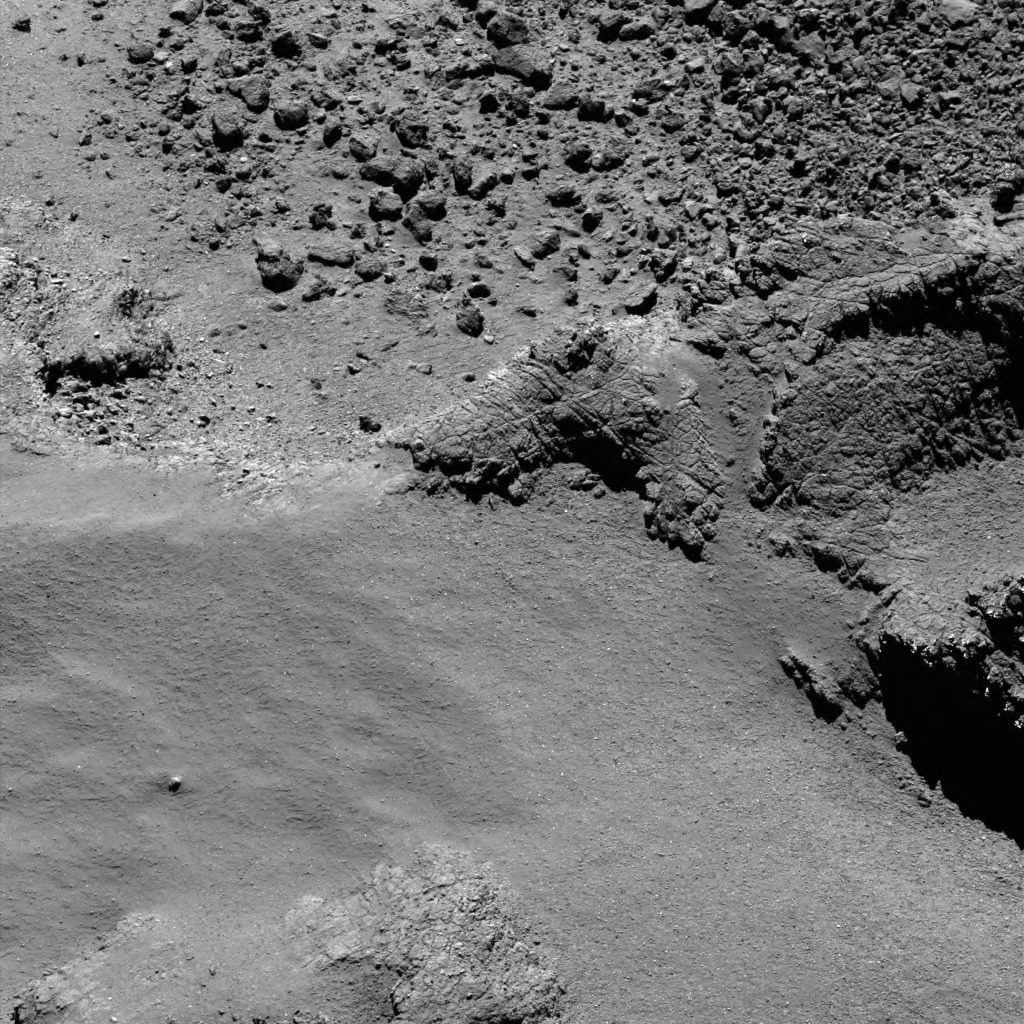
OSIRIS narrow-angle camera image taken on 3 August 2016, when Rosetta was 8.7 km from the centre of Comet 67P/Churyumov–Gerasimenko. The scale is 0.15 m/pixel at the comet and the image measures about 307 m. Credit: ESA/Rosetta/MPS for OSIRIS Team MPS/UPD/LAM/IAA/SSO/INTA/UPM/DASP/IDA
An image captured on 3 August (above) shows a striking contrast between very smooth plains, highly fractured outcrops, and a boulder strewn surface – all within a ~300 x 300 m square region in Seth.
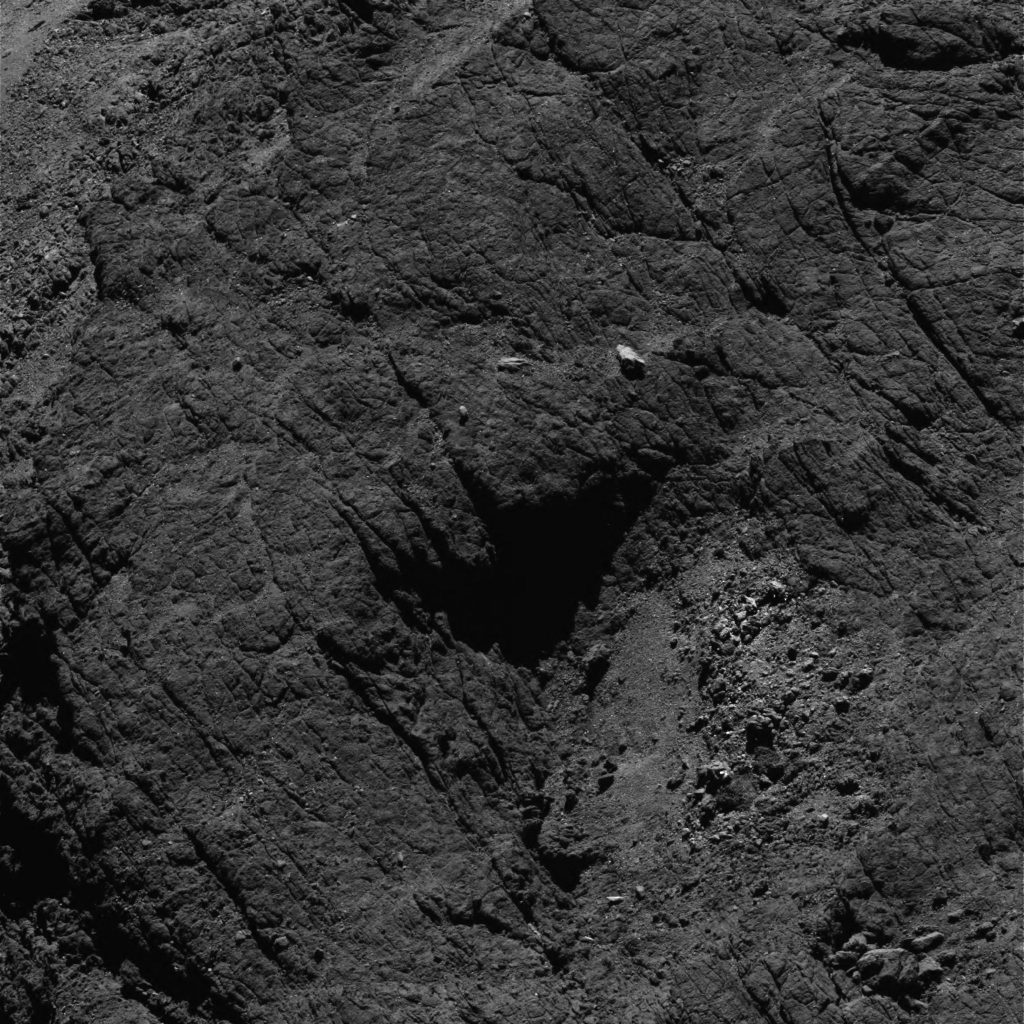
OSIRIS narrow-angle camera image taken on 6 August 2016, when Rosetta was 8.7 km from the centre of Comet 67P/Churyumov–Gerasimenko. The scale is 0.15 m/pixel at the comet and the image measures about 307 m. Credit: ESA/Rosetta/MPS for OSIRIS Team MPS/UPD/LAM/IAA/SSO/INTA/UPM/DASP/IDA
Meanwhile an image captured on 6 August (above) – the two year anniversary of Rosetta arriving at the comet – shows a heavily fractured region in Bastet, on the comet’s small lobe. A relatively smoother patch, home to an array of boulders, sits within the fractured terrain.
Finally, a great view over the large lobe was captured by Rosetta’s OSIRIS wide-angle camera on 10 August (below). It really shows off the curvature of the comet, and the contrasting terrains of Imhotep (left), Khepry and Aten (top/middle) and Ash (right).
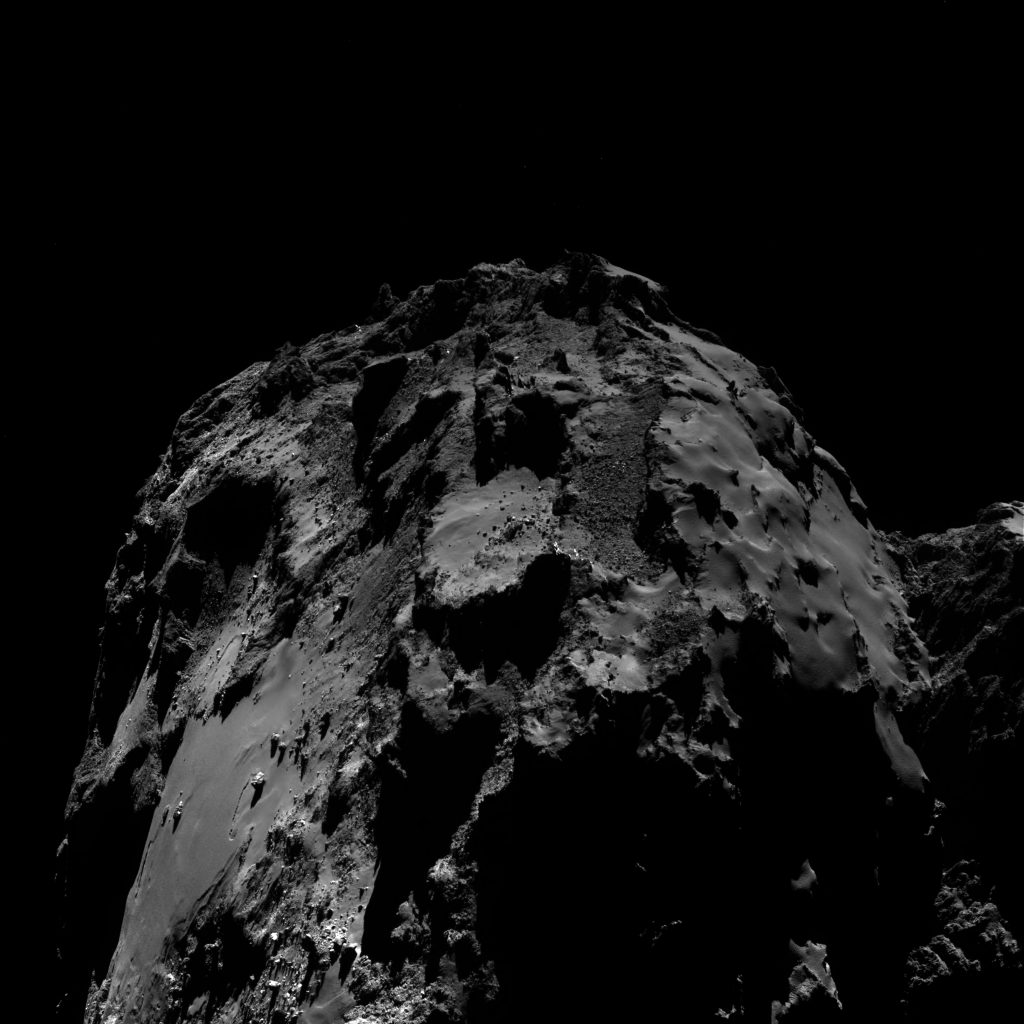
OSIRIS wide-angle camera image taken on 10 August 2016, when Rosetta was 12.8 km from the centre of Comet 67P/Churyumov–Gerasimenko. The scale is 1.18 m/pixel at the comet and the image measures about 2.4 km. Credits: ESA/Rosetta/MPS for OSIRIS Team MPS/UPD/LAM/IAA/SSO/INTA/UPM/DASP/IDA
And in case you missed it…don’t forget our two-year anniversary NAVCAM image here!
The original 1024 x 1024 pixel image of the NAVCAM image released today is provided below:
Quelle: ESA
-
Update: 1.09.2016
.
ROSETTA CAPTURES COMET OUTBURST
This article is mirrored from the ESA Portal.
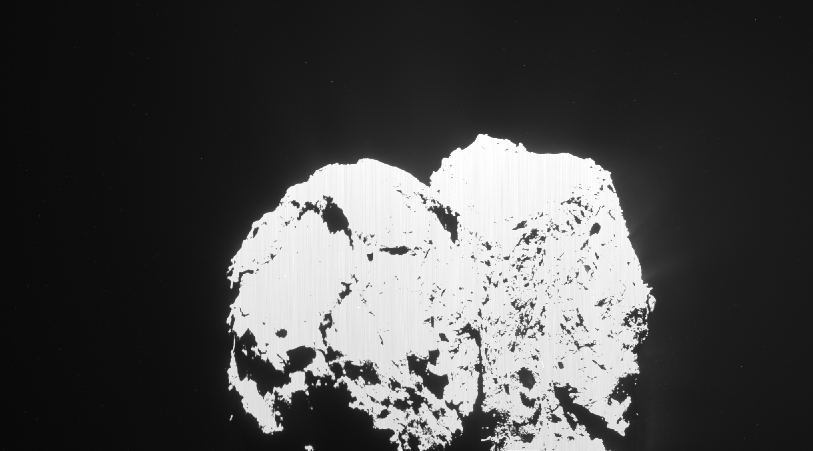
Rosetta’s OSIRIS wide-angle camera captured an outburst from the Atum region on Comet 67P/Churyumov–Gerasimenko’s large lobe on 19 February 2016. The images are separated by half an hour each, covering the period 08:40–12:10 GMT, and as such show the comet rotating. Credits: ESA/Rosetta/MPS for OSIRIS Team MPS/UPD/LAM/IAA/SSO/INTA/UPM/DASP/IDA
In unprecedented observations made earlier this year, Rosetta unexpectedly captured a dramatic comet outburst that may have been triggered by a landslide.
Nine of Rosetta’s instruments, including its cameras, dust collectors, and gas and plasma analysers, were monitoring the comet from about 35 km in a coordinated planned sequence when the outburst happened on 19 February.
“Over the last year, Rosetta has shown that although activity can be prolonged, when it comes to outbursts, the timing is highly unpredictable, so catching an event like this was pure luck,” says Matt Taylor, ESA’s Rosetta project scientist.
“By happy coincidence, we were pointing the majority of instruments at the comet at this time, and having these simultaneous measurements provides us with the most complete set of data on an outburst ever collected.”
The data were sent to Earth only a few days after the outburst, but subsequent analysis has allowed a clear chain of events to be reconstructed, as described in a paper led by Eberhard Grün of the Max-Planck-Institute for Nuclear Physics, Heidelberg, accepted for publication in Monthly Notices of the Royal Astronomical Society.
A strong brightening of the comet’s dusty coma was seen by the OSIRIS wide-angle camera at 09:40 GMT, developing in a region of the comet that was initially in shadow.
Over the next two hours, Rosetta recorded outburst signatures that exceeded background levels in some instruments by factors of up to a hundred. For example, between about 10:00–11:00 GMT, ALICE saw the ultraviolet brightness of the sunlight reflected by the nucleus and the emitted dust increase by a factor of six, while ROSINA and RPC detected a significant increase in gas and plasma, respectively, around the spacecraft, by a factor of 1.5–2.5.
In addition, MIRO recorded a 30ºC rise in temperature of the surrounding gas.
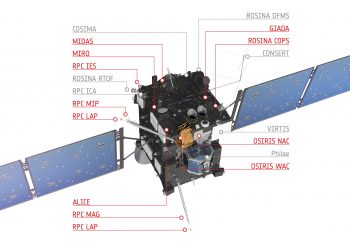
This diagram of Rosetta highlights (in red) the science instruments that were on and made detections of the 19 February 2016 outburst event, and that are presented in the study reporting the first analysis of the event. Credits: ESA/ATG medialab
Shortly after, Rosetta was blasted by dust: GIADA recorded a maximum hit count at around 11:15 GMT. Almost 200 particles were detected in the following three hours, compared with a typical rate of 3–10 collected on other days in the same month.
At the same time, OSIRIS narrow-angle camera images began registering dust grains emitted during the blast. Between 11:10 GMT and 11:40 GMT, a transition occurred from grains that were distant or slow enough to appear as points in the images, to those either close or fast enough to be captured as trails during the exposures.
In addition, the startrackers, which are used to navigate and help control Rosetta’s attitude, measured an increase in light scattered from dust particles as a result of the outburst.
The startrackers are mounted at 90º to the side of the spacecraft that hosts the majority of science instruments, so they offered a unique insight into the 3D structure and evolution of the outburst.
Astronomers on Earth also noted an increase in coma density in the days after the outburst.
By examining all of the available data, scientists believe they have identified the source of the outburst.
“From Rosetta’s observations, we believe the outburst originated from a steep slope on the comet’s large lobe, in the Atum region,” says Eberhard.
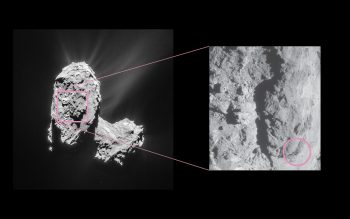
The source of the 19 February 2016 outburst was traced back to a location in the Atum region, on the comet’s large lobe. The inset image was taken a few hours after the outburst by Rosetta’s NavCam and shows the approximate source location. The image at left was taken on 21 March 2015 and is shown for context, and so there are some differences in shadowing/illumination as a result of the images being acquired at very different times. Credits: ESA/Rosetta/NavCam – CC BY-SA IGO 3.0
The fact that the outburst started when this area just emerged from shadow suggests that thermal stresses in the surface material may have triggered a landslide that exposed fresh water ice to direct solar illumination. The ice then immediately turned to gas, dragging surrounding dust with it to produce the debris cloud seen by OSIRIS.
“Combining the evidence from the OSIRIS images with the long duration of the GIADA dust impact phase leads us to believe that the dust cone was very broad,” says Eberhard.
“As a result, we think the outburst must have been triggered by a landslide at the surface, rather than a more focused jet bringing fresh material up from within the interior, for example.”
“We’ll continue to analyse the data not only to dig into the details of this particular event, but also to see if it can help us better understand the many other outbursts witnessed over the course of the mission,” adds Matt.
“It’s great to see the instrument teams working together on the important question of how cometary outbursts are triggered.”
---
COMETWATCH – LATE AUGUST ROUND-UP
This week's CometWatch entry was taken with Rosetta's NAVCAM on 17 August 2016, when the spacecraft was 13.9 km from the nucleus of Comet 67P/Churyumov-Gerasimenko.
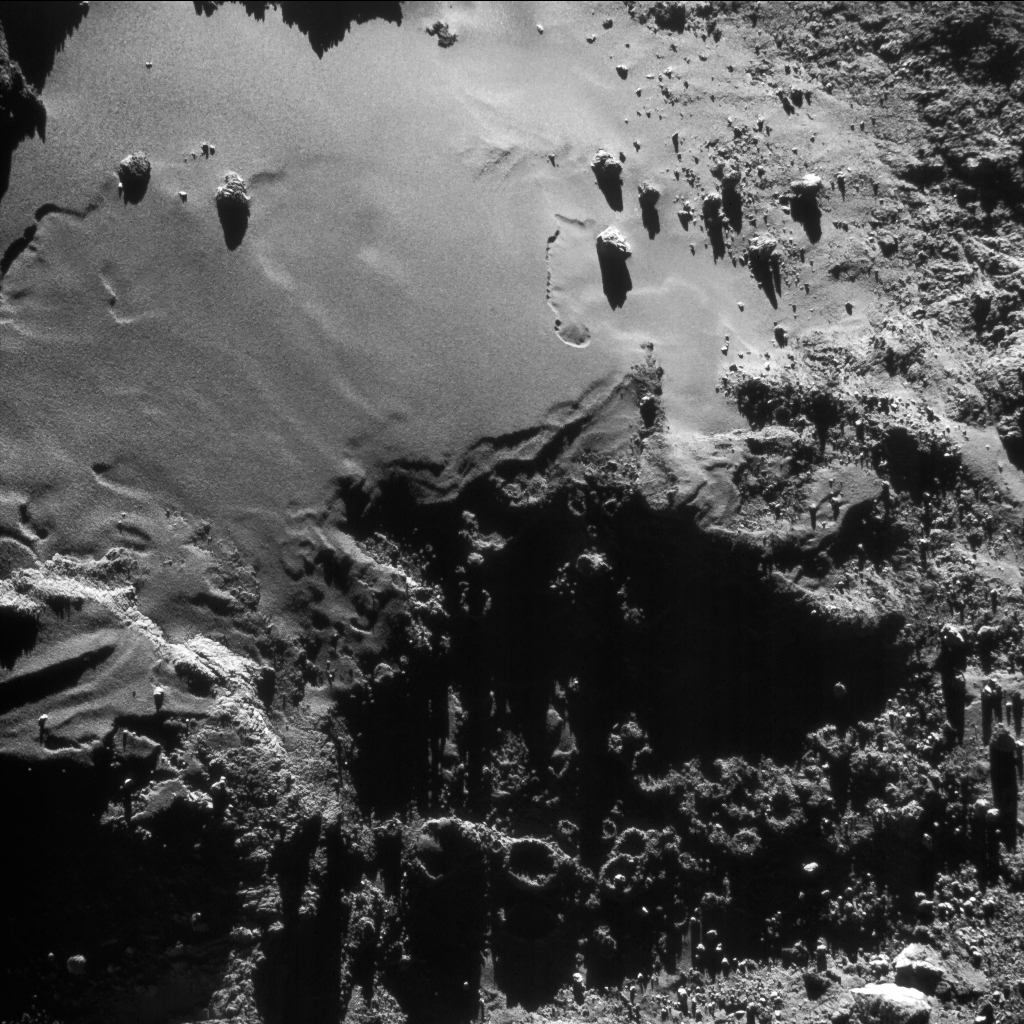
Enhanced NAVCAM image of Comet 67P/C-G taken on 17 August 2016, 13.9 km from the nucleus. The scale is 1.2 m/pixel and the image measures 1.2 km across. Credits: ESA/Rosetta/NAVCAM – CC BY-SA IGO 3.0
This close-up view shows a portion of the Imhotep region, on the large comet lobe.
The top part of the image portrays the flat, smooth-covered portion of Imhotep, scattered with a variety of boulders of different sizes. Towards the top right is a cluster of three large boulders, including the 45-m sized Cheops, named after the Great Pyramid at Giza near Cairo in Egypt.
Around the comet's perihelion, Rosetta observed many spectacular changes on this portion of Imhotep (see blog post 'Comet surface changes before Rosetta’s eyes').
To have an idea of the surface changes, you can compare the new CometWatch with a number of images of the same region taken in the past months by Rosetta: from early images such as CometWatch 26 October 2014 and the close fly-by of 14 February 2015 to more recent ones, for example this OSIRIS wide-angle camera image taken on 25 May 2016.
In the lower part of today's image, a number of circular features are visible, many of which appear to be stacked on top of one another. These roundish features can al

